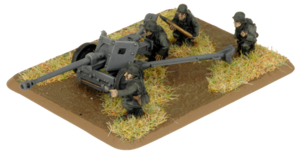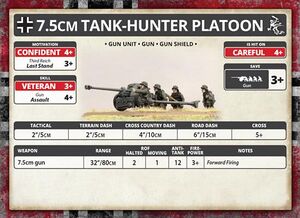PaK-40 Anti-Tank Gun

The PaK-40 Anti-Tank gun forms the majority of German towed AT capability in late war FoW. With an AP rating of 12 and RoF 2, it will take care of Shermans and T-34s with ease, and the gun shield makes it a little bit better at surviving.
The PaK-40 in Flames of War[edit | edit source]
The PaK-40 was in high demand in the real-world 1940s German military, so it can be seen on the front of a Fallschirmjaeger and a Waffen-SS infantry set's box, in both cases firing at an Allied tank. German Army, Waffen-SS, Luftwaffe paratroopers and the last-ditch Volkssturm and Hitlerjugend forces either all feature this gun in-game or can be plausibly armed with it in a made-up scenario. The PaK-40, like the Tiger, Opel Blitz and 8.8 flak cannon, was in greater demand than German industry could supply and appeared everywhere that Allied tanks did, manned by anyone the Germans could find to fire it.
Out of all these various uniformed crews, the big difference is skill and motivation. The Late War German Army stat card featured below shows a Confident Trained crew. Fallchirmjaeger and Waffen-SS gunners will be vastly more likely to possess the Fearless rating, but at a higher points cost.
Late War[edit | edit source]

By Late War, the PaK-40 appears in every German intelligence briefing, in one form or another. Being Germans, the PaK-40 is an expensive piece of kit, but at AP 12 it is a dangerous weapon to most enemy units. However, one must be wary of the late-late war books (such as Bridge at Remagen or Berlin), as by the time the war comes to an end your opponents will be able to field M26 Pershings, IS-2s and other such tanks with increased frontal armour. Firepower 3+ and RoF 2 are pretty bog-standard for AT Guns, but the addition of a Gun Shield makes it a little better at surviving. Of course, being a man-packed gun it moves pathetically slowly, and a concerted assault by infantry will make short work of your anti-tank platoon.
The best way to use the PaK-40 is, where possible, to deploy it as an ambush. Lie in wait for Allied tanks/vehicles to come along, let them get in range, then nail the coffin shut.
IRL[edit | edit source]
While it may seem impossible to many neckbeards and wargamers, the real world is in fact a thing. And in the aforementioned 'real world,' Nazi Germany went to war with, well, a lot of people. A lot of people with tanks. To kill these people (and blow up their tanks), the Germans came up with several types of AT (anti-tank) gun - first and foremost among these at the beginning of the war being the 3.7cm PaK-36. However, even before the war began, the Germans saw several flaws with the PaK-36 (namely, it wasn't good enough at killing tanks), and started a program to design some extremely technologically advanced AT guns, featuring all kinds of expensive, lightweight materials.
Following fears about the effectiveness of the then-brand new 5cm PaK-38 right at the beginning of the war, German engineers started making a new anti-tank gun, which would be designated as the 7.5cm Panzerabwehrkanone 40 (75mm Anti-Tank cannon to those of us in the anglosphere). This new gun offered much greater capabilities against enemy armoured vehicles whilst still being small, light and practical enough to be put into service. Furthermore, the gun, carriage and shield were made entirely from steel, a necessary step when the Luftwaffe had priority for all the lighter or more expensive materials needed for the PaK-38. Firing a 6.8kg shell at over 790 m/s, the PaK-40 could go through 132mm of Rolled Homogenous Steel Plate at 500m.
Whilst originally intended as a towed AT gun, there would, over the course of the war, be a great many vehicles fitted with the PaK-40, or its dedicated AFV-mounted variant, the Kampfwagenkanone-40 (Military Vehicle Gun 40, shortened to KwK-40 - this was designated StuK, or Sturmkanone 40, when mounted in assault guns but was identical to the KwK). These vehicles included assault guns such as the StuG III (Ausfuhrung F onwards), tank destroyers such as the Marder I, II and III and actual tanks such as the Panzer IV (Ausf. F.2 onwards). 23,303 PaK-40s were produced during the war, and it remained a potent and effective weapon right until the end.
| German Forces in Flames of War | |
|---|---|
| Tanks: | Panzer II - Panzer III - Panzer IV - Panther - Tiger - Tiger II - Panzer 38(t) - Captured Tank Platoon (Germany) |
| Transports: | SdKfz 250 - SdKfz 251 - Opel Blitzwagen |
| Infantry: | MG34 Platoon - AT-Rifle Team - Assault Pioneer Platoon - Grenadier Company - Fallshirmjager Company |
| Artillery: | PaK-40 Anti-Tank Gun - Hummel - Panzerwerfer 42 - Wespe - Grille - PaK-43 - 12cm Mortar - 8cm Mortar - 21cm Nebelwerfer 42 - 30cm Nebelwerfer 42 |
| Tank Destroyers and Assault guns: | Marder - StuG III - Jagdpanzer IV - Nashorn - Elefant - Jagdtiger - Brummbar - Hetzer - Sturmpanzer II Bison |
| Armored Cars: | SdKfz. 234/2 'Puma' - Sd.Kfz 222/223 - SdKfz. 231 |
| Aircraft: | JU-87 Stuka - HS-129 - ME-262 Sturmvogel |
| Anti-Aircraft: | Flak 88mm - Flakpanzer IV Wirbelwind & Ostwind |